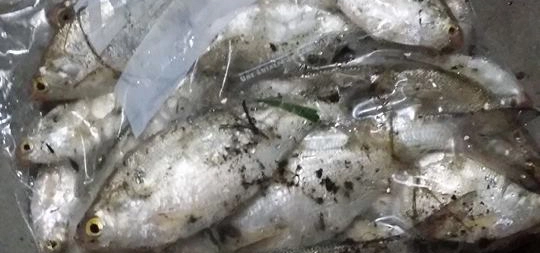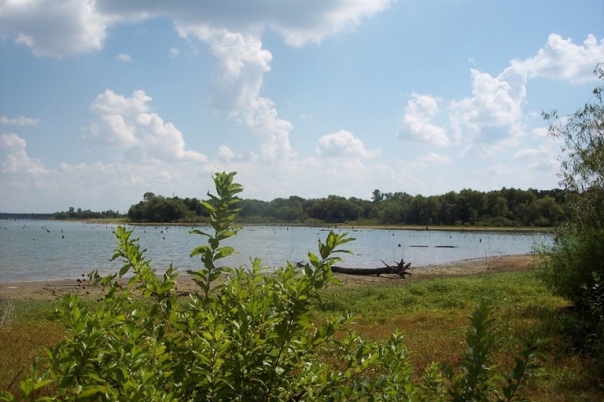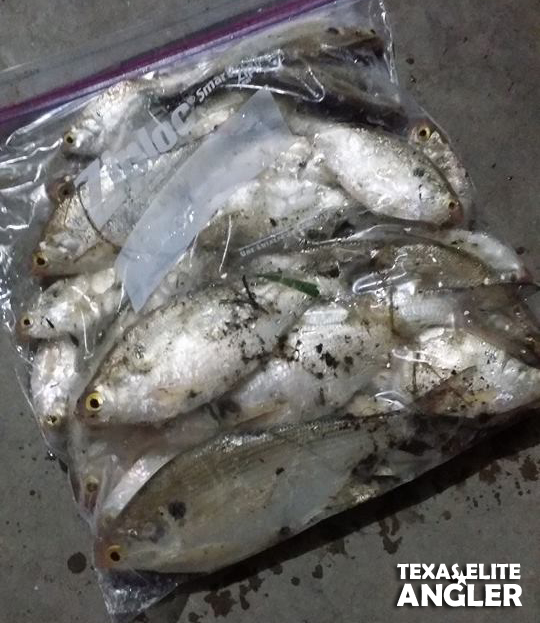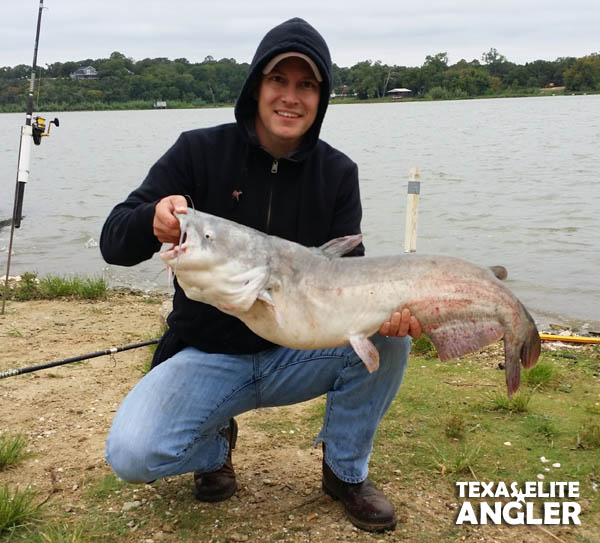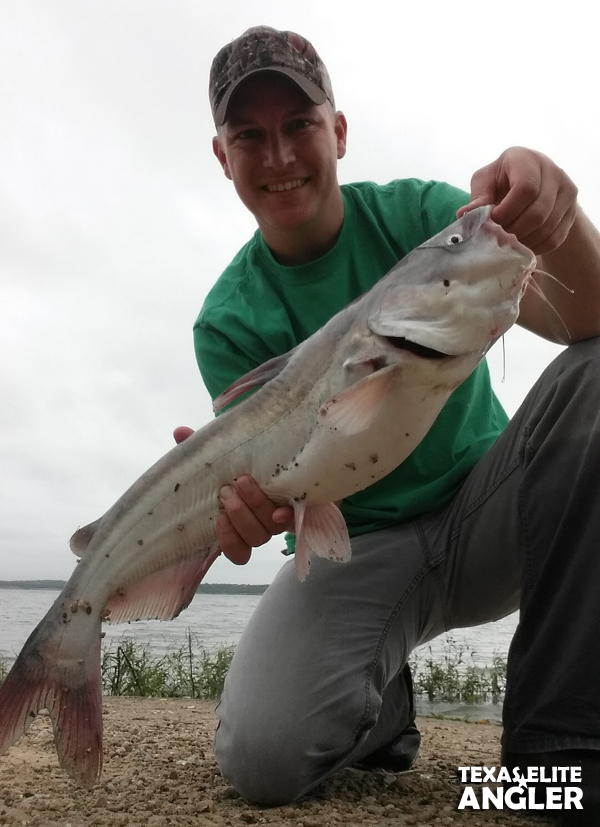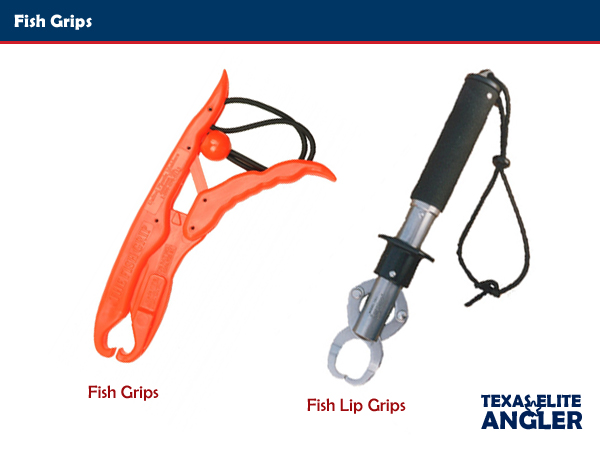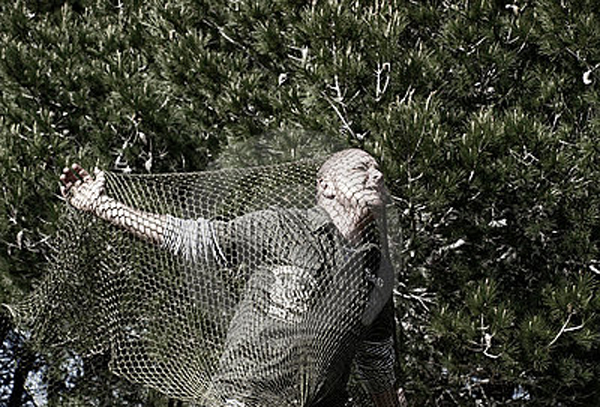Category Archives: Catfish Tactics
How Fresh Does Fresh Cut Shad Have To Be?
We’ve all heard and have generally accepted that fresh cut shad is better than frozen, but what constitutes fresh? How fresh is fresh? I’ve spent some time pondering this question because, like you, I want to be successful in landing big catfish and I certainly don’t want to stunt my chances by using bait that is less attractive to my target species.
How long are shad considered fresh?
You’ll probably get a different answer depending on who you ask, but within 24 hours of being caught is the consensus from my sources. I do believe catching them right at the spot you’re fishing and putting them right on the hook is obviously a better option, but sometimes that’s just not possible. Anything over 24 hours starts to drift into the “not-so-fresh” category.
What can you do to keep shad fresh?
It’s important to put the shad on ice quickly after you’ve caught them, unless you’re planning to fish live shad. This can be a challenge in itself because shad die pretty quickly in a bait bucket or cooler. In a square container they’ll nose in to a corner and suffocate themselves. In a bait buck there is simply not enough oxygen in the water to keep them alive. A good aerator and a larger cooler would be necessary if you want to keep them alive. There are also shad additives that you can add to the water to improve their chances of survival.
Should I Even Try Frozen Shad?
In the dead of winter, when shad are hard to get, it may be your best bet. If you ever have the option though, fresh shad is best — hands down.
Slip Sinker vs Santee Rig for Big Blue Catfish
You’re familiar with the rigs, the Slip Sinker holds the bottom and the Santee adds a float to raise the bait off the bottom. When fishing for blue catfish, particularly the big’guns, which rig is more likely to hook up? Allow me to answer that question with a story.
I was fishing Lake Lewisville today and as I was enjoying an absolutely mild, first-of-fall day this older gentleman who had been casting for bass starts picking his way down the bank toward me. I always love the opportunity to talk fishing with someone so I got up and greeted him as he got near enough to exchange pleasantries. Turns out he lives in the neighborhood up the road and fishes the area each morning. As usual he starts checking out my setup. I use banksticks and bite alarms (euro-fishing gear) and it always draws a few interested anglers.
After a quick demonstration of my gizmos, he asked what rig I use for catfish. Of course I answer with the question, which kind? It’s important to distinguish between the three common species (channel, blue, flathead) because while they’re all catfish, you target them in different ways. I saw the sparkle in his eye when he said, “The big blues.”
While the Slip Sinker rig is a killer rig for catfish, and I’m sure it’s caught its fair share of blue catfish, the Slip Sinker really lends itself better to catching Channel Cat. The reason being, Channel Cats simple don’t get as big as Blue Catfish, maxing out at about 30 lbs. So why does that matter? In the case of rig selection when targeting “Big” Blue Catfish, size does matter.
The bigger the catfish is, the more difficult it is for it to pick up food items that are laying flat on the bottom. 30+ pound Blue Catfish will prefer a bait that is suspended off the bottom because it can more easily get it into his mouth. This is where the Santee Rig shines. By adding the float and suspending your bait off the bottom you raise the chance of a good hook up with a trophy blue. Don’t worry, those smaller catfish don’t mind suspending to eat your bait.
One last thing to be sure of is to match your float size to your bait offering. A big chunk of shad will need a good 3″ float to pop it up. It’s a good idea to drop your rig shallow and test to see if your float can suspend your bait before casting out. If your selected float doesn’t have the muscle, switch it out for a bigger float. Catfish aren’t float shy, so don’t worry about a big’ole orange float close your the bait.
How To Catch Shad From The Bank
If you’re going to fish for big catfish you’ll need to learn to catch their favorite food item — shad. Live and fresh cut shad has no substitute. It’s simply the best bait you can present to hungry catfish. Don’t get me wrong, you can catch on frozen shad, cut carp, and buffalo; but your catch rate and quality will be greatly diminished.
For those of us who don’t have a boat…yet, we have to find and catch shad from the bank. This means throwing a cast net (video coming soon) into likely bait holding areas to haul them in. Since I’ve started regularly hunting shad from the shore, I thought I’d share some tips on where I have had the most luck so that you too can fill your bucket with great smelling, oily shad.
Where to target shad from the bank:
Boat Ramps: Have you ever watched boats load up on the trailer at a boat ramp? Inevitably the boat has to push with its motor to get the boat up on the trailer. This frequent blasting of the motor washes out a depression at the end of the ramp that baitfish love to occupy. Food items that baitfish eat will collect in this bowl, and so the baitfish hangout nearby and feed. The boat ramp itself serves as a banquet of sorts as algae grows on the textured concrete surface. Algae is on the menu for baitfish.
Rip Rap: Rip rap along a bank will hold baitfish as well much for the same reason as boat ramps. The crevices and cracks between the rocks will collect and hold food items. These cracks also serve as security for small fish who can use them to hide from predators. Algae will also grow on shallow rip rap creating a field of food for baitfish.
Docks or Piers: Especially if a dock or pier is lit at night. The light attracts insects which are definitely on the menu and the pilings serve as security for baitfish schools. The only cautionary advise I can give is some fishing piers will have intentionally sunken cover to attract sunfish and crappie to support fishing from the bank. This artificial structure will ruin a cast net quick.
Creek Outlets: The advantage of creek outlets is current. Current moves food items into the main water body, and baitfish will congregate here to feed as food items flow in. Watch out for submerged debris deposited by the current.
Windward Bank: If none of the above is available, try the windward bank. Wind, especially a good stiff wind, will push food items to the windward bank. Baitfish will congregate off the bank to feed. Keep moving as you throw your net as the shad will move after each throw. Come back to your starting point and try again as shad will quickly move back into the food zone.
Summer Pattern for Catfish
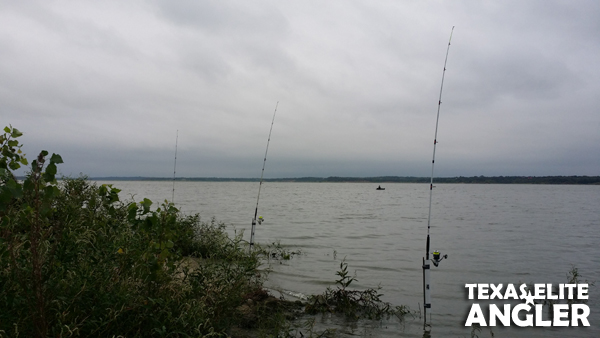 Early morning on Lewisville Lake
Early morning on Lewisville Lake
Your sitting on the bank, baking under the sun, squinting through sunglasses at your rod tips waiting for a bite. The bite is slow to none at all. The last action you saw was at dawn as the sun was beginning to color the sky. Sound familiar?
Take a look up and down the bank. What do you see? You may be the only one out there sweating. There may be another guy out there but he’s packing it up to leave. The baitfish have moved off, the dry land fauna has dissolved into the tree line, so what do you think the catfish are doing?
Bingo, they’ve moved off to a more comfortable spot, just like you should be doing. When in the dog days of summer the best times to fish for catfish (and any fish) will be in the early morning, or the late night when the temperatures are bearable, for you and the fish.
Why is this true? In your local lake, under the calm waves of lightly stained water, a battle for survival is going on. It’s an eat and be eaten ecology. Fish are on constant lookout for food and for bigger fish who can eat them. During the summer, especially midday when the sun is full press, there is a lot more light. Visibility extends further and fish can see each other better. For baitfish, this isn’t good. They do what any one of us would do if they see something big and hungry coming, they make a b-line for the nearest hiding place and lay low until conditions improve. Continuing normal activity would mean certain death. The catfish you’re fishing for follow the bait fish. You get a pass on overcast days. Temperatures are lower, and the available light is reduced.
Locating catfish becomes easier in the summer because you only have to find the following conditions:
Deep Structure:
Catfish move to deeper structure when the sun is in full force. The higher water temperatures and low oxygen in the shallows isn’t comfortable and so they simply won’t be there. Look for deep ledges, depressions, or points where catfish can ambush baitfish in the comfort of cooler water.
Cover:
Heavy cover is another likely location for catfish and other fish. The shade presents cooler water and the cover sets up a good ambush. Thick cover like fallen trees, grass mats, submerged timber or stumps, and bridge pilings are ideal summer rest stops for catfish looking to get out of the heat.
Current:
Moving water cures two of the summer heat conditions — low oxygen and high temperature water. Current brings cooler water and the movement oxygenates the water. In addition to these two boons, current also carries food, namely baitfish among other food items. Catfish are predators of opportunity and can’t resist a meal that comes to them.
The Perfect Storm:
If you can find deep structure with cover and current then you’ve found a honey hole for summertime catfish. I’ve heard it said that catfish school in these summer haunts with members of like weight. This means 10-pounders will hang out with other 10-pounders and so on. The exception is the large catfish (50+). Big catfish are lone wolf hunters and will run off lesser fish in a prime location.
The Bottom Line:
For summertime catfish, look to deep holes, cover and current. Fish early or fish late. Save your midday for spending quality time with your loved ones.
How To Prepare For A Fishing Tournament
Some fisherman are purists and simply enjoy being outdoors and experiencing nature and care little if they catch or not. As long as there are drinks in the cooler and good conversation these fisherman are content. Others, like myself, enjoy angling. We consider the weather conditions, seasonal fish patterns and study hydrographic maps to increase our chances of catching more and bigger fish during our time spent on the bank or in the boat. This amount of focus lends itself to competition where an angler can test his or her skills along side other anglers. Fishing tournaments and derbies are the best outlet for not only measuring an angler but also for networking with other like-minded fisherman. Even the saltiest angler may pick up a new trick, innovation or technique through the course of the tournament.
Next week I will be competing in the Austin Team Challenge (ATC), a carp angling event on the metropolitan Lady Bird Lake in Austin, Texas. In the US carp fishing community this is a significant event that attracts carp anglers from around the country. With my registration paid and a tidy sum spent on equipment and bait, all that remains is to prepare. This is how I go about it.
The Physical Preparation:
Don’t be a Fool, Re-spool:
Starting on the gear side of preparation, the first thing I consider is my line — that vital connection between me and a carp (aka Points). If my line has been on the reel for more than 12 months, it’s got to go. If the line hasn’t hit it’s first birthday, then I check it over. If I detect any weakness in the line such as twist or nicks, it’s got to go. The confidence I feel from freshly spooled line feels great so it doesn’t take much to make me strip a reel and respool fresh line.
Fill the Rig Wallet:
If you snag up and snap off you have to be ready to tie on a new rig. You don’t want to have to spend precious fishing time fiddling with rig components. That rubber bead seems to get three times smaller and the line three times thicker when the clock is ticking. Taking the time to tie up back-up rigs will save you a lot of time and you’ll appreciate the relief when you can simply pluck out a rig, tie up and get back out in the water in a matter of moments.
You can also use the per-tournament preparation time to tie up rigs for different applications. If you arrive at your fishing spot to find conditions aren’t favorable for your current rig, you can quickly switch over to a new rig designed for the unexpected condition. Consider the various conditions you could find yourself in and tie a rig to match each, this way whatever comes your way, you’ll be ready while your competitor goes back to the tackle box.
Fresh Batteries and Back-ups:
If you’re using equipment that requires batteries, save yourself some grief by stocking up on the appropriate batteries. Put a fresh set in your powered gear so you know it will perform at 100% power, then put a set in your tackle box or gear bag just in case.
Stock up on Bait:
Have a confidence bait or fishing a tourney that allows chumming? If so, then load up and bring more than you’ll need. Any excess will get used in future fishing sessions, but don’t get caught short. You can’t catch fish if you run out of bait.
The Gear Check and Clean Up:
I like to take time before a tournament to pull out all my fishing gear and give it a good once over, cleaning as I go. How do the eyes look on those rods, still good? I also find it helpful to organize the tackle box. The act of cleaning and organizing your tackle will orient you to where everything is at. When a particular bit or tool is needed you’ll know just where to go to put a finger on it.
The Mental Preparation:
Check Weather Conditions
About a week out from D-day you should check the weather conditions. If you’re in Texas you might want to wait until a couple days before — things change fast in these parts. This is important for a number of reasons. Weather conditions will tell you where the fish will likely be, provide clues to their behavior and help to cull down gear, bait and rig choices.
Weather will also dictate clothing choices and what additional gear you’ll need for your comfort while fishing. I once fished a tournament without a good coat when the weather had turned cold and it was miserable. Never again.
Study the Map:
Dore the Explorer got it right. The map, the map, the map is very important. A hydrographic map of the tournament waters will zero you in that much further. The lake contours and structure will reveal some likely fish haunts and this intel combined with weather conditions will go along way to putting you on to fish.
Hit the Forums:
I’m about to drop a secret here so get your pen ready. Drawing down on a tournament folks can get mighty tight lipped, but those same contestants were sharing fishing experiences openly six months to year ago on the fishing community website or forum. Conducting a few targeted forum searches could yield you some important intelligence on the tourney waters and help you with tackle and bait choices.
Get a Good Night’s Sleep:
Exhaustion and sleep deprivation will dull your senses and judgement. You may consider and make choices that you would not normally make. Exhaustion will sap your confidence and confidence is your best weapon in a tournament setting. It’s good to network and have a good time with your angling buddies, but set a limit and allow yourself enough time to get a good sleep. Fishing tourneys generally start early-early in the morning. Be ready.
The Spiritual Preparation:
Visualize Success:
As goofy and new-age as it sounds, visualizing success is a valuable step. Mentally rehearse your tournament session. See yourself making those perfect casts, reading the subtle bite indications and landing the big fish. It’s ok to imagine a good weigh-in and see the elation on your face. Through the process of mentally rehearsing you’ll identify any gaps in your process and remind yourself of the little things that make a difference. This exercise will develop in you a muscle memory that will have you casting in better form and not overplaying the fish.
Positive Self-talk:
Another odd suggestion, but try it. Start your morning with a positive affirmation that you are a talented angler, that you will win the day and you’ll be more likely to do so. Starting your day with a defeated attitude will lead to your defeat.
Pray:
As a Christian, prayer is a powerful tool in my tackle box. Pray for grace and positive character. Tournaments can bring the worst out in people. Pray for yours and the other anglers’ safety. As important as fishing is to us anglers, it’s not worth an injury. Pray for favorable conditions and an abundance of fish — it never hurts to throw that in there.
I would be interested hear about what you do to prepare. Any tips, please share by dropping me a note at txeliteangler@verizon.net
Cat Tactics :: How to Hold a Catfish Without Getting Hurt
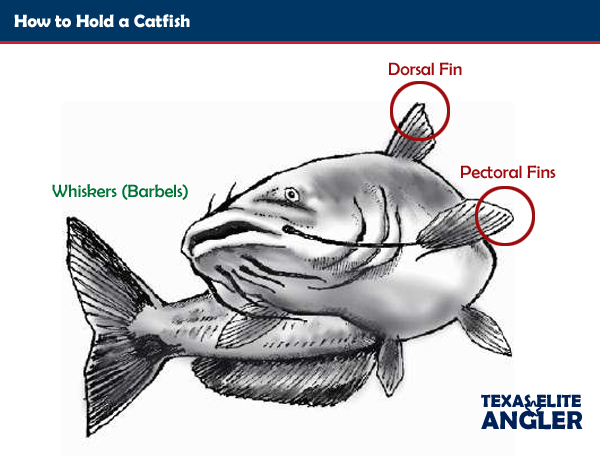 So you’ve landed a catfish and your friend who so confidently man handles these fish is nowhere around to rescue you. It’s time to grab the bull by the horns, or in this case, the cat by the torso and deal with it. You’ve probably heard that catfish can sting you so looking over this beast what looks most apt to do the stinging? Those long, sinister whiskers look to be the likely culprit. Touch one of those and you get stung proper, right? Wrong.
So you’ve landed a catfish and your friend who so confidently man handles these fish is nowhere around to rescue you. It’s time to grab the bull by the horns, or in this case, the cat by the torso and deal with it. You’ve probably heard that catfish can sting you so looking over this beast what looks most apt to do the stinging? Those long, sinister whiskers look to be the likely culprit. Touch one of those and you get stung proper, right? Wrong.
A catfish’s whiskers are not defensive structures and they’re absolutely incapable of delivering a sting of any sort. Whiskers, or more accurately Barbels, are actually an organ that is packed with what amounts to taste buds that help the fish locate food in low visibility waters. Barbels are often referred to as Barbs which may have led to the villainous characterization. A catfish’s barbels are quite soft and are more likely to tickle you than sting you.
So can a catfish sting you? Oh yes, it can. I got poked once under my thumb nail and it was excruciatingly painful. There are two types of fins you have to respect, the Dorsal and the Pectorals. Each is edged with a sturdy spine that ends in a sharp point. This is more prominent in young catfish whose spines are more like needles. Older, larger catfish have dulled down their spines and present less of a concern.
So how do they sting? Well, similar to any creature that stings, the spines are covered with skin that contain glandular cells that produce a protein, or venom, that is released when the spine penetrates your skin. It’s this venom that stings the ever loving crap’ola out of you. The good news is the spines are easy to avoid and stings are rare if you handle the catfish respectfully.
Old Angler’s Tip: If you get stung, rub the stung area on the catfish’s belly. The belly slime is said to neutralize the venom. Not very sanitary, but the same could be said about peeing on a bull-nettle sting. Personally, I’d recommend a doctor if the catfish stabbed you deep or the sting is severe.
So how do you hold a catfish to avoid getting hurt? Three ways.
1. From the Belly (for smaller cats)
Slide your hand up from tail to head on the belly side. Find a grip beneath the pectorals where the rib cage will provide a hand hold. Grabbing from the belly will keep the dorsal pointed away from you.
2. From the Back (for smaller cats)
Grab the catfish behind the head, finding your grip under the pectorals and above the dorsal. You can push down the dorsal to keep it down and out of the way. If the cat gets frisky, keep a sure grip. If the dorsal rises it could stick you.
3. Fish Grips (For big cats)
If you get into to some big cats gripping them with a hand will become problematic as their girth will be to wide to grip depending on how big your hands are. This is where fish grips come into play. There are two widely used grips pictured below. Either do the job.
Respect your Catch:
It’s also worth noting that the bigger the fish is, the more damage you can do when handling them. Fish aren’t designed to be out of water and their vital organs aren’t well protected. Holding a big fish vertically can shift it’s internal organs into a damaging, even death-dealing fashion. They may swim away, but die hours later. When holding fish over 10lbs, its recommended to support their bodies vertically so as to not damage their organs. This applies to weighing as well. Invest in a weigh sling that will provide you a safe way to weigh your catch.
The Cast Net Blues
I’ve gotten soft. Fishing for carp and buffalo, with all its high-tech gear and gadgets has distanced me from the real roll-up-your sleeves and get dirty style of fishing. I don’t have to say how much more appealing mixing up oats and corn for carp is compared to catching and cutting up live bait. It reminds me of the days of tearing worms into bits for panfish, except on a texas chainsaw massacre scale. I’m trying to view cut bait as a right of passage that I’ll find comfort in through practice. Of course I know once I land my first 20-pound blue cat I’ll be lopping off fish heads with maniacal glee just to get another chance at a trophy cat.
This brings me to my current arch-nemesis, The Cast Net (queue dastardly villain theme). This simple implement of free bait is convincing me that inanimate objects can posses an evil sentience. Its unwieldy, awkward and even a little intimidating. My first few unsuccessful throws landed in a pattern similar to a coin slot — needless to say not very effective at trapping bait. I managed only one really unlucky gizzard shad and a microscopic blue gill fry.
Going to the place I always turn to when I’m facing a life challenge, You Tube had lots to offer in instructional videos. There are a myriad of techniques each claiming to be the easiest. Some using your teeth, which smacks of disaster, and others that double the net up as many as four times.
Stinking thinking had me wondering if I could just buy live bait, but my angler’s heart knows that live bait from the water body your fishing will out fish anything store bought on any day. Cast netting for live bait is simply a necessary evil that you have to master if you want to bank big kitties.
Experienced Angler’s Tip:
Gizzard Shad, a blue cat’s bait of choice, are easiest to catch in the daylight hours around docks and boat ramps.
~Cliff, Experienced Cat Angler
